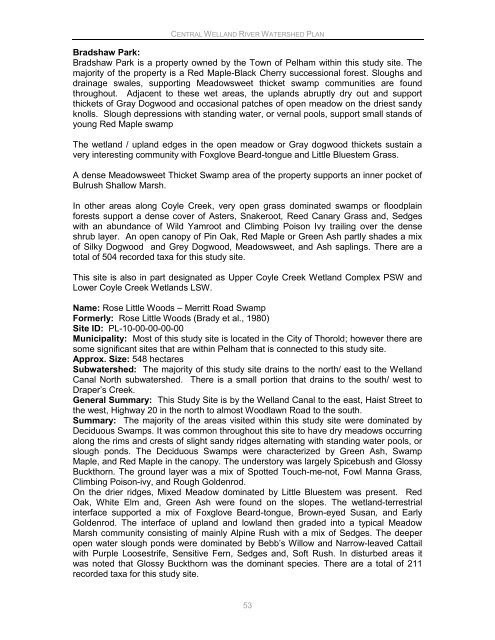Central Welland River Watershed Plan - Niagara Peninsula ...
Central Welland River Watershed Plan - Niagara Peninsula ...
Central Welland River Watershed Plan - Niagara Peninsula ...
- No tags were found...
Create successful ePaper yourself
Turn your PDF publications into a flip-book with our unique Google optimized e-Paper software.
CENTRAL WELLAND RIVER WATERSHED PLANBradshaw Park:Bradshaw Park is a property owned by the Town of Pelham within this study site. Themajority of the property is a Red Maple-Black Cherry successional forest. Sloughs anddrainage swales, supporting Meadowsweet thicket swamp communities are foundthroughout. Adjacent to these wet areas, the uplands abruptly dry out and supportthickets of Gray Dogwood and occasional patches of open meadow on the driest sandyknolls. Slough depressions with standing water, or vernal pools, support small stands ofyoung Red Maple swampThe wetland / upland edges in the open meadow or Gray dogwood thickets sustain avery interesting community with Foxglove Beard-tongue and Little Bluestem Grass.A dense Meadowsweet Thicket Swamp area of the property supports an inner pocket ofBulrush Shallow Marsh.In other areas along Coyle Creek, very open grass dominated swamps or floodplainforests support a dense cover of Asters, Snakeroot, Reed Canary Grass and, Sedgeswith an abundance of Wild Yamroot and Climbing Poison Ivy trailing over the denseshrub layer. An open canopy of Pin Oak, Red Maple or Green Ash partly shades a mixof Silky Dogwood and Grey Dogwood, Meadowsweet, and Ash saplings. There are atotal of 504 recorded taxa for this study site.This site is also in part designated as Upper Coyle Creek Wetland Complex PSW andLower Coyle Creek Wetlands LSW.Name: Rose Little Woods – Merritt Road SwampFormerly: Rose Little Woods (Brady et al., 1980)Site ID: PL-10-00-00-00-00Municipality: Most of this study site is located in the City of Thorold; however there aresome significant sites that are within Pelham that is connected to this study site.Approx. Size: 548 hectaresSubwatershed: The majority of this study site drains to the north/ east to the <strong>Welland</strong>Canal North subwatershed. There is a small portion that drains to the south/ west toDraper‟s Creek.General Summary: This Study Site is by the <strong>Welland</strong> Canal to the east, Haist Street tothe west, Highway 20 in the north to almost Woodlawn Road to the south.Summary: The majority of the areas visited within this study site were dominated byDeciduous Swamps. It was common throughout this site to have dry meadows occurringalong the rims and crests of slight sandy ridges alternating with standing water pools, orslough ponds. The Deciduous Swamps were characterized by Green Ash, SwampMaple, and Red Maple in the canopy. The understory was largely Spicebush and GlossyBuckthorn. The ground layer was a mix of Spotted Touch-me-not, Fowl Manna Grass,Climbing Poison-ivy, and Rough Goldenrod.On the drier ridges, Mixed Meadow dominated by Little Bluestem was present. RedOak, White Elm and, Green Ash were found on the slopes. The wetland-terrestrialinterface supported a mix of Foxglove Beard-tongue, Brown-eyed Susan, and EarlyGoldenrod. The interface of upland and lowland then graded into a typical MeadowMarsh community consisting of mainly Alpine Rush with a mix of Sedges. The deeperopen water slough ponds were dominated by Bebb‟s Willow and Narrow-leaved Cattailwith Purple Loosestrife, Sensitive Fern, Sedges and, Soft Rush. In disturbed areas itwas noted that Glossy Buckthorn was the dominant species. There are a total of 211recorded taxa for this study site.53
















